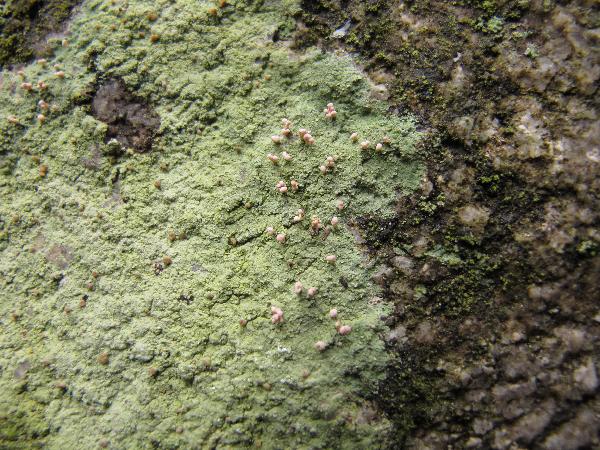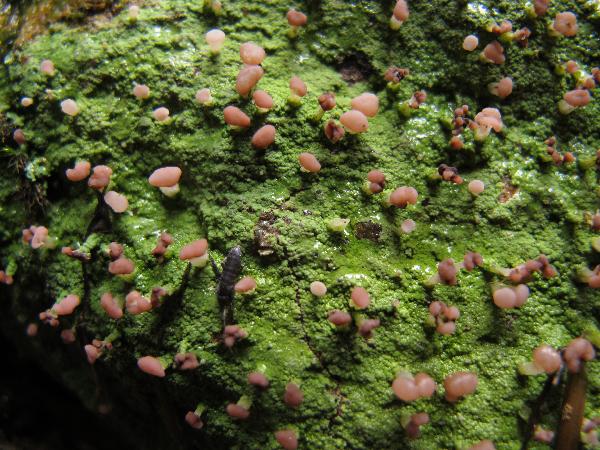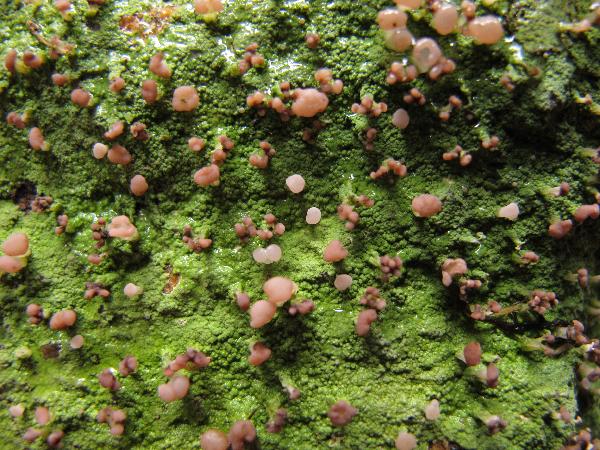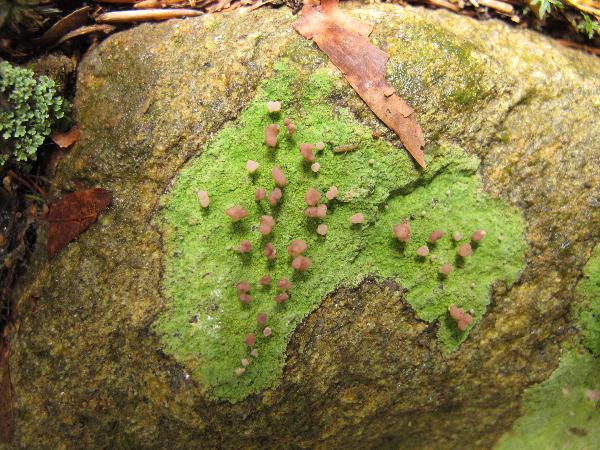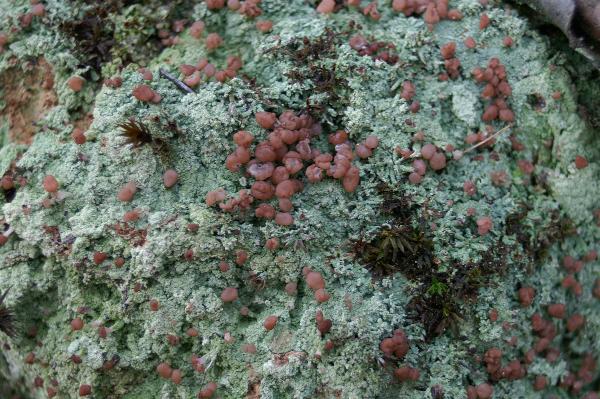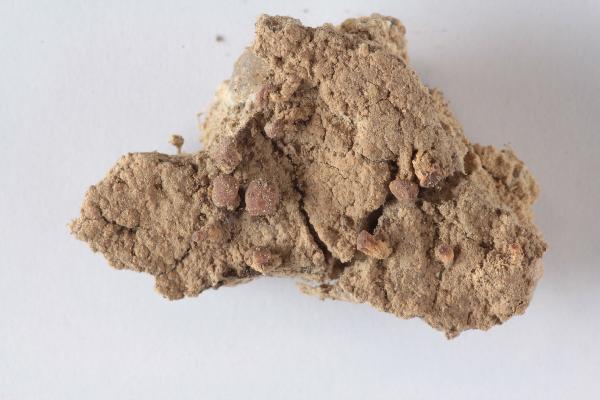Baeomyces rufus (Huds.) Rebent.
Prodr. Flor. Neomarch.: 315, 1804. Basionym: Lichen rufus Huds. - Fl. Angl.: 443, 1762.
Synonyms: Baeomyces caesiopruinosus (Anzi) Jatta?; Baeomyces rufus f. rupestris Harm.; Baeomyces rupestris Pers.; Biatora byssoides (L.) Fr.; Lichen fungiformis Scop.; Rinodina humilis H. Magn.; Rinodina humilis H. Magn.; Sphyridium byssoides (L.) Beltr.; Sphyridium fungiforme (Scop.) Flot.
Description: Primary thallus crustose, grey-green to greenish white, more rarely brownish, thick, continuous to areolate-subsquamulose, forming up to 20 cm wide patches, the areoles convex, contiguous, to 1 mm broad, with a warty to smooth cortex, esorediate or often powdery-sorediate, the soredia greenish grey; schizidia rare, sparse, 0.2-0.3 mm across. Apothecia frequent, biatorine, emarginate, with a red-brown, flat to convex, marginally often in-rolled disc, up to 2.5 mm across, single or coalescing, rarely sessile, usually brought on erect, fruticose, smooth, flattened to subcylindrical, often longitudinally fissured, ecorticate or basally corticate, white stipes which are 2-6(-9) mm tall. Epithecium brownish, C+ red; hymenium colourless, 75-130 µm high, K/I-; paraphyses simple to sparingly branched in upper part, slender, (1-)1.5-2 µm thick, the apical cell only slightly wider; hypothecium pale. Asci 8-spored, cylindrical, thin-walled, the apex truncated, with a single functional wall layer, with a poorly differentiated, non-amyloid tholus. Ascospores 1(-2)-celled, hyaline, fusiform, (7.5-)8-12(-14) x (2.5-)3-4(-5) µm. Pycnidia rare. Conidia bacilliform, 4-5 x c. 1 µm. Photobiont chlorococcoid. Spot tests: thallus K+ yellow, C-, KC+ yellow, P+ orange-yellow, UV+ pale yellow; mature apothecia C+ red. Chemistry: thallus with stictic acid (major), norstictic acid and an unidentified substance (traces); mature apothecia with gyrophoric and lecanoric acids.
Growth form: Crustose
Photobiont: green algae other than Trentepohlia
Reproductive strategy: mainly sexual
Pioneer species
Commonnes-rarity: (info)
Alpine belt: rather rare
Subalpine belt: rather common
Montane belt: rather rare
Dry submediterranean belt: rare
Humid submediterranean belt: rather rare
Padanian area: absent
pH of the substrata:
1 2 3 4 5
Solar irradiation:
1 2 3 4 5
Aridity:
1 2 3 4 5
Eutrophication:
1 2 3 4 5
Poleotolerance:
0 1 2 3
Altitudinal distribution:
1 2 3 4 5 6
Rarity
absent
extremely rare
very rare
rare
rather rare
rather common
common
very common
extremely common
Loading data...
Occurrence data
Predictive map
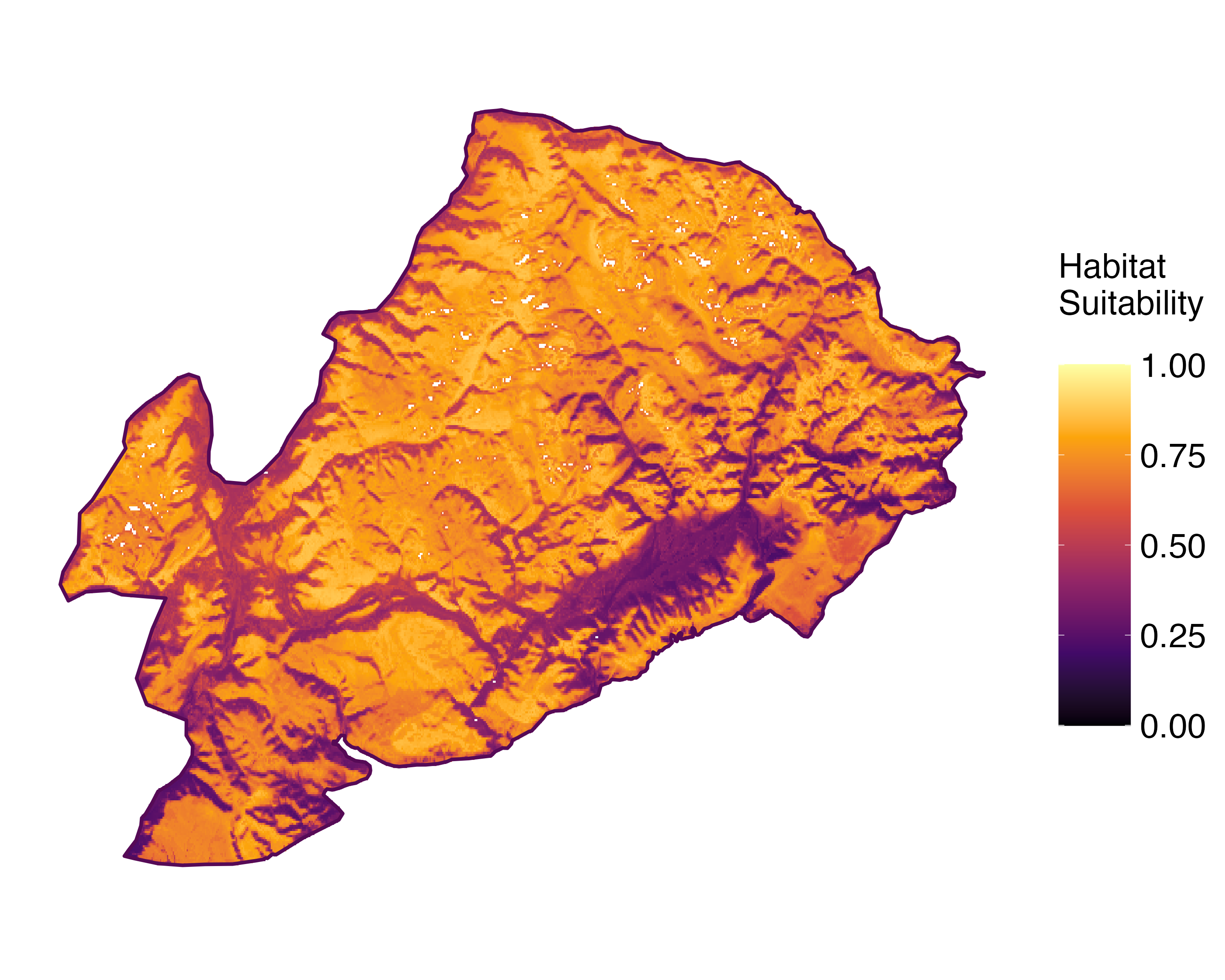 Current prediction (1981-2010)
Current prediction (1981-2010) Future prediction (2071-2100) SSP 1-2.6
Future prediction (2071-2100) SSP 1-2.6 Future prediction (2071-2100) SSP 5-8.5Predictive maps according to Francesconi et al. 2025
Future prediction (2071-2100) SSP 5-8.5Predictive maps according to Francesconi et al. 2025
P.L. Nimis; Owner: Department of Life Sciences, University of Trieste
Herbarium: TSB (14271)
2001/12/09

P.L. Nimis; Owner: Department of Life Sciences, University of Trieste
Herbarium: TSB (14271)
2001/12/09

P.L. Nimis; Owner: Department of Life Sciences, University of Trieste
Italy, Friuli Venezia Giulia, Udine, Passo del Pura, Ampezzo Carnico, 1400 m
09.09.2016

Felix Schumm – CC BY-SA 4.0
[6983], Germany, Baden-Württemberg, Kreis Göppingen, Marbachtal bei Zell-Börtlingen, auf Sandboden in Bachnähe, luftfeucht, lichtoffen, ca. 350 m, TK 7223. Leg. Schumm & Schwarz 24.04.2000, det. Schumm 2000

Felix Schumm – CC BY-SA 4.0
[6983], Germany, Baden-Württemberg, Kreis Göppingen, Marbachtal bei Zell-Börtlingen, auf Sandboden in Bachnähe, luftfeucht, lichtoffen, ca. 350 m, TK 7223. Leg. Schumm & Schwarz 24.04.2000, det. Schumm 2000

Felix Schumm – CC BY-SA 4.0
[6983], Germany, Baden-Württemberg, Kreis Göppingen, Marbachtal bei Zell-Börtlingen, auf Sandboden in Bachnähe, luftfeucht, lichtoffen, ca. 350 m, TK 7223. Leg. Schumm & Schwarz 24.04.2000, det. Schumm 2000

Felix Schumm – CC BY-SA 4.0
[6983], Germany, Baden-Württemberg, Kreis Göppingen, Marbachtal bei Zell-Börtlingen, auf Sandboden in Bachnähe, luftfeucht, lichtoffen, ca. 350 m, TK 7223. Leg. Schumm & Schwarz 24.04.2000, det. Schumm 2000

Felix Schumm – CC BY-SA 4.0
[6983], Germany, Baden-Württemberg, Kreis Göppingen, Marbachtal bei Zell-Börtlingen, auf Sandboden in Bachnähe, luftfeucht, lichtoffen, ca. 350 m, TK 7223. Leg. Schumm & Schwarz 24.04.2000, det. Schumm 2000

Felix Schumm – CC BY-SA 4.0
[6983], Germany, Baden-Württemberg, Kreis Göppingen, Marbachtal bei Zell-Börtlingen, auf Sandboden in Bachnähe, luftfeucht, lichtoffen, ca. 350 m, TK 7223. Leg. Schumm & Schwarz 24.04.2000, det. Schumm 2000

Felix Schumm – CC BY-SA 4.0
[6983], Germany, Baden-Württemberg, Kreis Göppingen, Marbachtal bei Zell-Börtlingen, auf Sandboden in Bachnähe, luftfeucht, lichtoffen, ca. 350 m, TK 7223. Leg. Schumm & Schwarz 24.04.2000, det. Schumm 2000

Felix Schumm – CC BY-SA 4.0
[6983], Germany, Baden-Württemberg, Kreis Göppingen, Marbachtal bei Zell-Börtlingen, auf Sandboden in Bachnähe, luftfeucht, lichtoffen, ca. 350 m, TK 7223. Leg. Schumm & Schwarz 24.04.2000, det. Schumm 2000

Felix Schumm – CC BY-SA 4.0
[6983], Germany, Baden-Württemberg, Kreis Göppingen, Marbachtal bei Zell-Börtlingen, auf Sandboden in Bachnähe, luftfeucht, lichtoffen, ca. 350 m, TK 7223. Leg. Schumm & Schwarz 24.04.2000, det. Schumm 2000

Felix Schumm – CC BY-SA 4.0
[6983], Germany, Baden-Württemberg, Kreis Göppingen, Marbachtal bei Zell-Börtlingen, auf Sandboden in Bachnähe, luftfeucht, lichtoffen, ca. 350 m, TK 7223. Leg. Schumm & Schwarz 24.04.2000, det. Schumm 2000

Courtesy: Olivier et Danièle Gonnet - Source: https://www.afl-lichenologie.fr/Photos_AFL/Photos_AFL_B/Baeomyces_rufus.htm
France, Pollionnay, sentier forestier - Rhône
6/1/2018

Courtesy: Olivier et Danièle Gonnet - Source: https://www.afl-lichenologie.fr/Photos_AFL/Photos_AFL_B/Baeomyces_rufus.htm
France, Pollionnay, sentier forestier - Rhône
6/1/2018

Courtesy: Olivier et Danièle Gonnet - Source: https://www.afl-lichenologie.fr/Photos_AFL/Photos_AFL_B/Baeomyces_rufus.htm
France, Pollionnay, sentier forestier - Rhône
6/1/2018

Bernard Bouffinier - Source: http://www.lichensmaritimes.org/index.php?task=fiche&lichen=129&lang=en
France, Forêt du Cranou

Bernard Bouffinier - Source: http://www.lichensmaritimes.org/index.php?task=fiche&lichen=129&lang=en
France, Forêt du Cranou

Bernard Bouffinier - Source: http://www.lichensmaritimes.org/index.php?task=fiche&lichen=129&lang=en
France, Forêt du Cranou

Jacques Haine - Source: http://www.lichensmaritimes.org/index.php?task=fiche&lichen=129&lang=en
France, Monthermé

Jacques Haine - Source: http://www.lichensmaritimes.org/index.php?task=fiche&lichen=129&lang=en
France, Ardennes

Jacques Haine - Source: http://www.lichensmaritimes.org/index.php?task=fiche&lichen=129&lang=en
France, Ardennes

Jacques Haine - Source: http://www.lichensmaritimes.org/index.php?task=fiche&lichen=129&lang=en
France, Ardennes

Ulrich Kirschbaum CC BY-SA 4.0 - Source: https://www.thm.de/lse/ulrich-kirschbaum/flechtenbilder
Central Europe; Germany; Bavaria: Allgäu.

Ulrich Kirschbaum CC BY-SA 4.0 - Source: https://www.thm.de/lse/ulrich-kirschbaum/flechtenbilder
Central Europe; Germany; Bavaria: Allgäu.
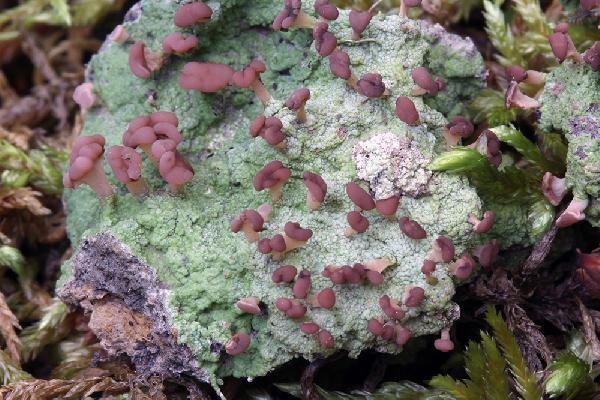
Marta González Garcia - Centro de Estudios Micologicos Asturianos
La Corredoria, (Pola de Laviana-Asturias), 12-IX-2017, en un talud sombrío.
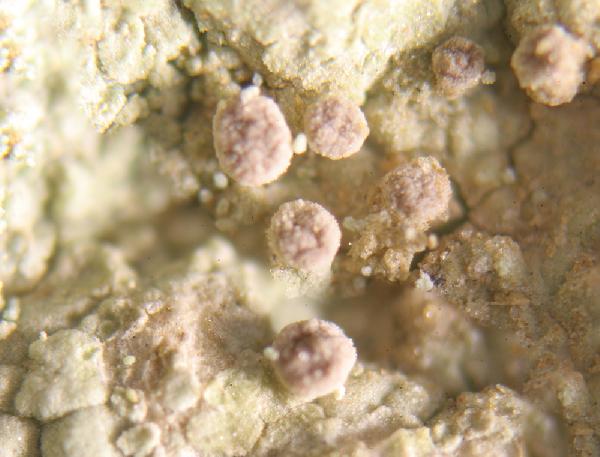
Marta González Garcia - Centro de Estudios Micologicos Asturianos
La Corredoria, (Pola de Laviana-Asturias), 12-IX-2017, en un talud sombrío.
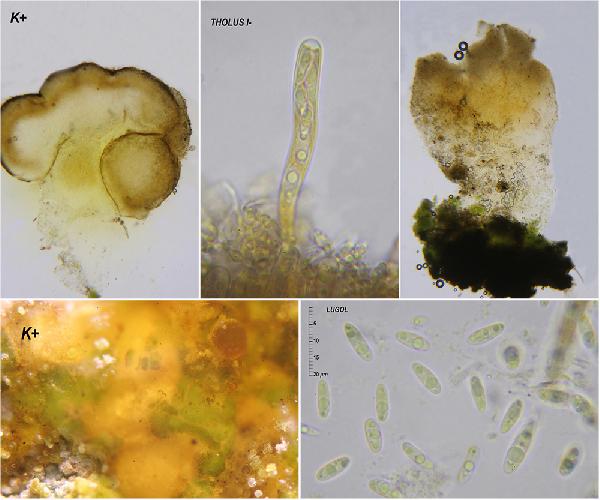
Marta González Garcia - Centro de Estudios Micologicos Asturianos
La Corredoria, (Pola de Laviana-Asturias), 12-IX-2017, en un talud sombrío.
Growth form: Crustose
Photobiont: green algae other than Trentepohlia
Reproductive strategy: mainly sexual
Pioneer species
Commonnes-rarity: (info)
Alpine belt: rather rare
Subalpine belt: rather common
Montane belt: rather rare
Dry submediterranean belt: rare
Humid submediterranean belt: rather rare
Padanian area: absent
pH of the substrata:
| 1 | 2 | 3 | 4 | 5 |
Solar irradiation:
| 1 | 2 | 3 | 4 | 5 |
Aridity:
| 1 | 2 | 3 | 4 | 5 |
Eutrophication:
| 1 | 2 | 3 | 4 | 5 |
Poleotolerance:
| 0 | 1 | 2 | 3 |
Altitudinal distribution:
| 1 | 2 | 3 | 4 | 5 | 6 |
Rarity
absent
extremely rare
very rare
rare
rather rare
rather common
common
very common
extremely common
Loading data...
Occurrence data
Predictive map
 Current prediction (1981-2010)
Current prediction (1981-2010) Future prediction (2071-2100) SSP 1-2.6
Future prediction (2071-2100) SSP 1-2.6 Future prediction (2071-2100) SSP 5-8.5
Future prediction (2071-2100) SSP 5-8.5Predictive maps according to Francesconi et al. 2025

P.L. Nimis; Owner: Department of Life Sciences, University of Trieste
Herbarium: TSB (14271)
2001/12/09

P.L. Nimis; Owner: Department of Life Sciences, University of Trieste
Herbarium: TSB (14271)
2001/12/09

P.L. Nimis; Owner: Department of Life Sciences, University of Trieste
Italy, Friuli Venezia Giulia, Udine, Passo del Pura, Ampezzo Carnico, 1400 m
09.09.2016

Felix Schumm – CC BY-SA 4.0
[6983], Germany, Baden-Württemberg, Kreis Göppingen, Marbachtal bei Zell-Börtlingen, auf Sandboden in Bachnähe, luftfeucht, lichtoffen, ca. 350 m, TK 7223. Leg. Schumm & Schwarz 24.04.2000, det. Schumm 2000

Felix Schumm – CC BY-SA 4.0
[6983], Germany, Baden-Württemberg, Kreis Göppingen, Marbachtal bei Zell-Börtlingen, auf Sandboden in Bachnähe, luftfeucht, lichtoffen, ca. 350 m, TK 7223. Leg. Schumm & Schwarz 24.04.2000, det. Schumm 2000

Felix Schumm – CC BY-SA 4.0
[6983], Germany, Baden-Württemberg, Kreis Göppingen, Marbachtal bei Zell-Börtlingen, auf Sandboden in Bachnähe, luftfeucht, lichtoffen, ca. 350 m, TK 7223. Leg. Schumm & Schwarz 24.04.2000, det. Schumm 2000

Felix Schumm – CC BY-SA 4.0
[6983], Germany, Baden-Württemberg, Kreis Göppingen, Marbachtal bei Zell-Börtlingen, auf Sandboden in Bachnähe, luftfeucht, lichtoffen, ca. 350 m, TK 7223. Leg. Schumm & Schwarz 24.04.2000, det. Schumm 2000

Felix Schumm – CC BY-SA 4.0
[6983], Germany, Baden-Württemberg, Kreis Göppingen, Marbachtal bei Zell-Börtlingen, auf Sandboden in Bachnähe, luftfeucht, lichtoffen, ca. 350 m, TK 7223. Leg. Schumm & Schwarz 24.04.2000, det. Schumm 2000

Felix Schumm – CC BY-SA 4.0
[6983], Germany, Baden-Württemberg, Kreis Göppingen, Marbachtal bei Zell-Börtlingen, auf Sandboden in Bachnähe, luftfeucht, lichtoffen, ca. 350 m, TK 7223. Leg. Schumm & Schwarz 24.04.2000, det. Schumm 2000

Felix Schumm – CC BY-SA 4.0
[6983], Germany, Baden-Württemberg, Kreis Göppingen, Marbachtal bei Zell-Börtlingen, auf Sandboden in Bachnähe, luftfeucht, lichtoffen, ca. 350 m, TK 7223. Leg. Schumm & Schwarz 24.04.2000, det. Schumm 2000

Felix Schumm – CC BY-SA 4.0
[6983], Germany, Baden-Württemberg, Kreis Göppingen, Marbachtal bei Zell-Börtlingen, auf Sandboden in Bachnähe, luftfeucht, lichtoffen, ca. 350 m, TK 7223. Leg. Schumm & Schwarz 24.04.2000, det. Schumm 2000

Felix Schumm – CC BY-SA 4.0
[6983], Germany, Baden-Württemberg, Kreis Göppingen, Marbachtal bei Zell-Börtlingen, auf Sandboden in Bachnähe, luftfeucht, lichtoffen, ca. 350 m, TK 7223. Leg. Schumm & Schwarz 24.04.2000, det. Schumm 2000

Felix Schumm – CC BY-SA 4.0
[6983], Germany, Baden-Württemberg, Kreis Göppingen, Marbachtal bei Zell-Börtlingen, auf Sandboden in Bachnähe, luftfeucht, lichtoffen, ca. 350 m, TK 7223. Leg. Schumm & Schwarz 24.04.2000, det. Schumm 2000

Courtesy: Olivier et Danièle Gonnet - Source: https://www.afl-lichenologie.fr/Photos_AFL/Photos_AFL_B/Baeomyces_rufus.htm
France, Pollionnay, sentier forestier - Rhône
6/1/2018

Courtesy: Olivier et Danièle Gonnet - Source: https://www.afl-lichenologie.fr/Photos_AFL/Photos_AFL_B/Baeomyces_rufus.htm
France, Pollionnay, sentier forestier - Rhône
6/1/2018

Courtesy: Olivier et Danièle Gonnet - Source: https://www.afl-lichenologie.fr/Photos_AFL/Photos_AFL_B/Baeomyces_rufus.htm
France, Pollionnay, sentier forestier - Rhône
6/1/2018

Bernard Bouffinier - Source: http://www.lichensmaritimes.org/index.php?task=fiche&lichen=129&lang=en
France, Forêt du Cranou

Bernard Bouffinier - Source: http://www.lichensmaritimes.org/index.php?task=fiche&lichen=129&lang=en
France, Forêt du Cranou

Bernard Bouffinier - Source: http://www.lichensmaritimes.org/index.php?task=fiche&lichen=129&lang=en
France, Forêt du Cranou

Jacques Haine - Source: http://www.lichensmaritimes.org/index.php?task=fiche&lichen=129&lang=en
France, Monthermé

Jacques Haine - Source: http://www.lichensmaritimes.org/index.php?task=fiche&lichen=129&lang=en
France, Ardennes

Jacques Haine - Source: http://www.lichensmaritimes.org/index.php?task=fiche&lichen=129&lang=en
France, Ardennes

Jacques Haine - Source: http://www.lichensmaritimes.org/index.php?task=fiche&lichen=129&lang=en
France, Ardennes

Ulrich Kirschbaum CC BY-SA 4.0 - Source: https://www.thm.de/lse/ulrich-kirschbaum/flechtenbilder
Central Europe; Germany; Bavaria: Allgäu.

Ulrich Kirschbaum CC BY-SA 4.0 - Source: https://www.thm.de/lse/ulrich-kirschbaum/flechtenbilder
Central Europe; Germany; Bavaria: Allgäu.

Marta González Garcia - Centro de Estudios Micologicos Asturianos
La Corredoria, (Pola de Laviana-Asturias), 12-IX-2017, en un talud sombrío.

Marta González Garcia - Centro de Estudios Micologicos Asturianos
La Corredoria, (Pola de Laviana-Asturias), 12-IX-2017, en un talud sombrío.























